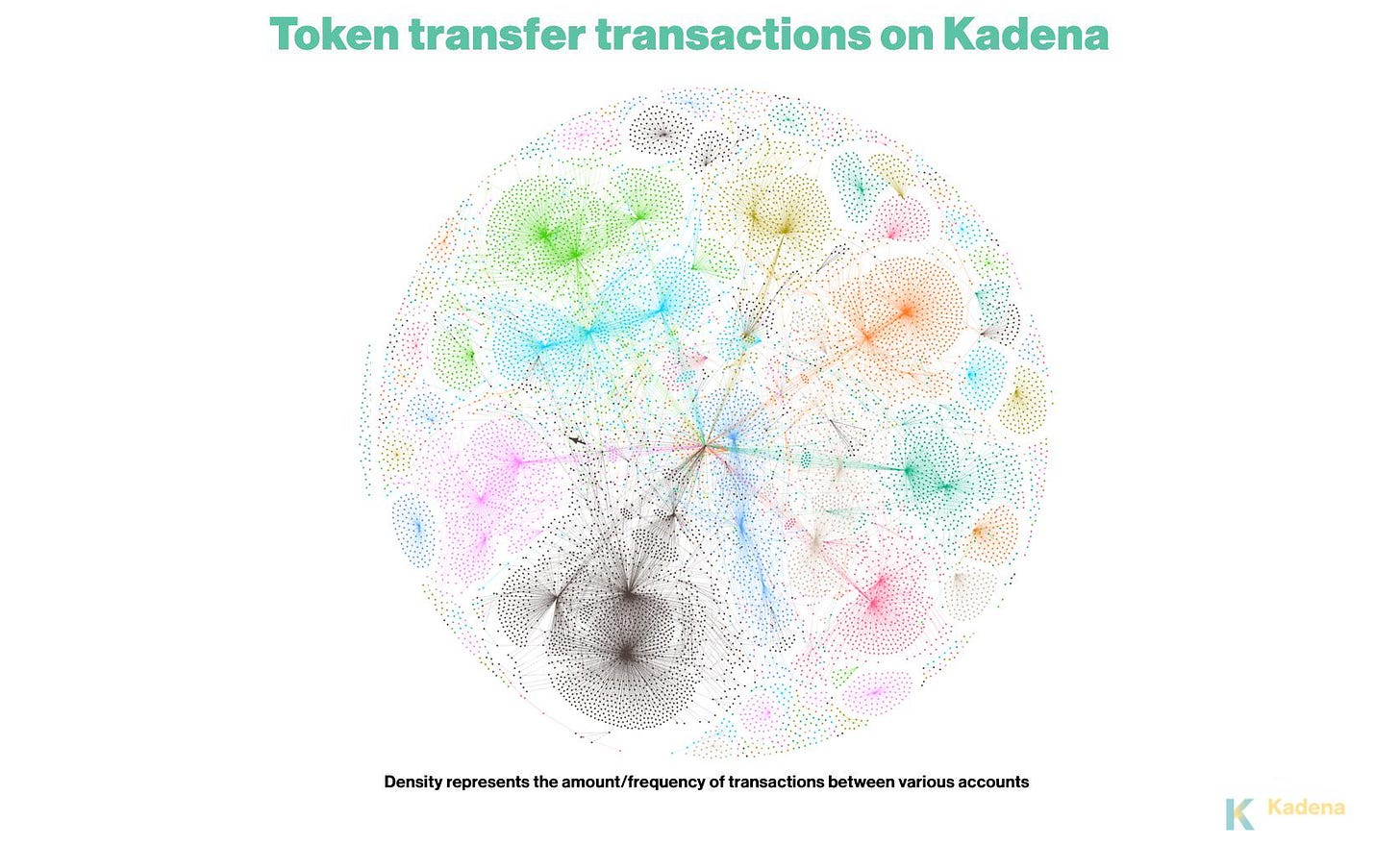Continued from Part 1.
📌 Kadena
Contributor: Tony Pham, Head of Marketing at Kadena
Since our last update about 6 weeks ago, over five million blocks have been mined on Kadena's public network, a 25% increase.

Kadena's hash rate has grown by 50% to consistently above 150 TH / s. Last month, we were averaging 100 TH / s. (Hash rate is a general measure of a network's processing power.

There have been over 84,000 successful token transfers on the Kadena network. Here is a graph of the growth along with a visualization of the transactions between various accounts.


18.4 million KDA coins are in circulation. There is also an updated version of the Kadena Block Explorer that was recently released (link). The block explorer is an analytics tool for the Kadena platform which visualizes the mining, propagation, and braiding of blocks across multiple Kadena PoW chains in real time. The tool allows you to search for transactions and explore the contents of blocks. For example, if someone runs a cross-chain transfer that doesn't complete, that person can now query their account, locate the unfinished transaction, and get the information necessary to complete the transaction.
📌 Nervos CKB
Contributor: Jane Wu, CKB Community
It has been five months since Nervos CKB launched its mainnet Lina in November. With an average block time of ~7.8 seconds and an average uncle rate (percentage of blocks that were created during short forks) of ~2.5%, Lina is stable and growing stronger every day.
Hashrate. With the emergence of ASICs, hashrate on CKB has grown ~30x to 6.69 PH/S from an average about 200TH/S prior to ASICs. CKB uses a simple and new hash function to make it easier for ASIC production and it has seen a rare case of multiple manufacturers delivering CKB ASICs given it is a new PoW blockchain, as comparison it took four years for Bitcoin ASIC to appear. There were four ASIC rigs announced, of which three have been shipped and the hashrate is expected to continue growing in the coming months. The graph below shows the hashrate growth since mainnet launch.

Number of addresses and Cells. The number of new addresses and Cells being created on CKB each day has been growing for 5 straight months. A Cell is a generalized UTXO and the most basic structure needed to represent a single piece of data on the blockchain. While the data contained in a Bitcoin UTXO could only be Bitcoin balance or static data (as a OP_RETURN tx), the data contained in a Cell can take many forms, including CKB tokens, code like Javascript, or even serialized data like JSON strings. There are no restrictions on the type of data included, so developers have complete flexibility in what they choose to work with. As of writing, there are 30,860 addresses and 139,120 active cells. As the below two graphs show.


DAO deposits. The native token of Nervos CKB is known as CKByte or CKB for short. One CKB entitles the holder to one byte of data storage on the blockchain, it is also used to pay any fees associated with transactions and computation. CKB can also be deposited in the Nervos Dao where they gain interest in a process similar to staking.
The token-economics of CKB is designed to provide long-term holders an effectively supply-capped coin similar to Bitcoin. It has a hard-capped issuance of 33.6 billion CKB as block rewards with the amount issued halving every 4 years, and a secondary issuance at a rate of 1.344 billion CKB per year. Based on CKB coin usage, the secondary issuance is divided among 1) miners, 2) Nervos DAO depositors and 3) a treasury fund (which is being burned until the ecosystem fund in the genesis block is depleted). By depositing in the Nervos DAO, the CKB holdings will never be diluted by secondary issuance.
The deposits in Nervos Dao have seen continuous growth too. Below is a graph showing the growth of Nervos Dao deposits since mainnet launch. As of writing, 4.94 billion CKB (~34.9% of the circulating supply) is locked in Nervos DAO at 3.47% APC (annual percentage compensation).

Ecosystem. A $30M grants program was set to fund infrastructure level development and future applications. Eight teams have received grants and are working on CKB infrastructure, recipients include: @abc_wallet, @Grow_Fi, @obsidian_labs, @SECBIT_IO, @obsidian_llc, #synapse, #lay2 and @summa_one.
Nervos has partnered with China Merchants Bank to explore #DeFi use cases on CKB for customers and clients. Huobi Finance Chain launched testnet, which is built on CKB’s layer2 framework Muta.

